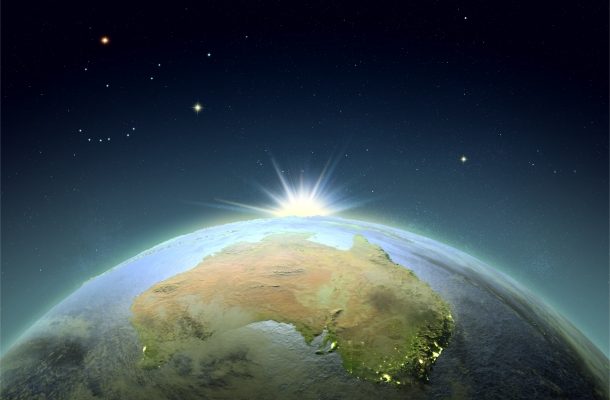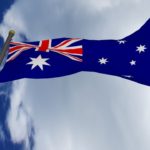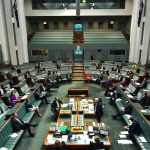Innovation in outer space and opportunities for Australia

Australia’s space industry needs to catch up with the rest of the world. Andrea Boyd, Flight Operations Engineer from the International Space Station in Germany, explained why at the recent GAP Summit.
As mentioned, I’m a Flight Controller for the International Space Station. It’s my day job to work with the astronauts from Mission Control and help them stay alive, plus do hundreds of science experiments and maintain complex space engineering systems. That means, when the Astronauts call Earth, most of the time my Aussie accent answers back to Space. However, space is rarely about astronauts or going to Mars. It’s about satellites.
The Space Sector supports the needs of many diverse interests:
- Innovation
- Defence
- National Security
- The Environment
- Telecommunications and Navigation
- High-Tech Employment and Infrastructure
- The pursuit of STEM: Science, Technology, Engineering and Mathematics for young people.
Australia presently has very little indigenous capability or participation in this growing sector with regard to the design and construction of space infrastructure like satellites. The Optus and NBN satellites were built by the USA and launched by Europe – nothing Australian about them except footing the $2billion bill each time. This means that when Australia buys a satellite from an American company, it is not able to receive the actual plans for the satellite. Should anything go wrong, it needs to be returned to the USA for repairs. Zero Australian jobs/ technology/ innovation. On the same rocket as the first NBN satellite, Skymuster 1, was a 100% Argentinean designed and built satellite, also for broadband internet – a country with a GDP per capita five times smaller than Australia’s, and which has its own space agency.
America buys space from Americans, the Europeans buy from the Europeans and the Australians have a habit of buying from the Americans and the Europeans. We don’t buy from ourselves. Australia has outstanding capabilities in processing, interpreting, using and developing new applications for data derived from satellites, especially to manage things like our natural resources – including water, crops, oceans, vegetation – and monitor things like weather, climate, natural disasters and urban growth. We clearly need space technology, we pay for it and we have the intellectual and technological capabilities to design and build it ourselves: yet we don’t. Not acting soon could see Australia’s space industry fall too far behind the rest of the world to ever catch up to rapidly advancing technologies. It’s a $350billion a year industry about to grow dramatically in which Australia doesn’t participate, aside from sending several billion dollars overseas each year to pay other countries to do space activities for us.
For Australia space is about doing things we already do and need as a nation better, cheaper, more effectively using satellites. Australia has many strategic reasons to be involved in space. Our nation covers a huge land mass – the sixth largest in the world – we share an inordinate responsibility for the Earth’s surface in respect to our population. Australia’s National Satellite Utilisation Policy and Defence White Papers confirm that national defence, economy, agriculture and communication have critical requirements in relation to satellite imagery, SATCOM, and GPS navigation. We operate as a 100% import space economy spending billions annually buying other nations’ satellite data for this. Yes, we run ground stations for other space agencies, have Optus and NBN ground stations and we have excellent astronomy (again, ground stations) and the school programs and Academia are high, even attracting international students, but after that they either work in something completely unrelated to space if graduates wish to remain in Australia. Or more commonly, they move overseas. Woomera has been primarily a defence site, not a space site, for almost 50 years, with the exception of sounding rocket campaigns that used to allow many students like me to do their aerospace thesis; even these activities have sadly not been allowed for many years now.
So, we’re here to talk innovation – Innovation as we’ve heard today is anything new that changes the society adopting it. Australia is ranked 19th in the world on the 2016 Global Innovation Index. Despite this growth, our productivity performance has been lagging for almost a decade. In space it has been lagging for 5 decades. The Department of Industry estimates that innovation drives 60% of Australian productivity, and that is why we must be resolute in our commitment to it and the space sector is key.
Innovation is of course about new businesses as well. Startups over the last decade in Australia have added over 2million jobs across all industries. Very few are space as most people still think they need to move overseas to innovate in this sector – this was very real in the past but certainly not the present, nor the future. The partial successes in the space industry in Australia are thanks largely to fragmented individual perseverance and funding, rather than government support. This must be owned together with some spectacular failures and poor past decisions in our historical policy and its application to both new and existing endeavours.
The Government has just amended the tax system to encourage investors to direct their funds towards high-growth, innovative startups. This is ideal as international investment in space just last year was the equivalent of the last 10 years combined. Venture Capitalists who aren’t Trekkies and have no particular care for space as an industry are now seeing it as the industry which will innovate and give the greatest returns in the future. Australians leading new companies via PlanetLabs (in USA) and RocketLabs (in New Zealand) combined have raised nearly $500m in investment, money Australia missed out on. There are a good dozen space startups in Australia right now, and whether they survive or move overseas is up to us. Australian new space companies have done it tough, yet last year 1/3rd of them raised investments ranging from seed funding to Series A. So what has changed to enable such resilience in a hazardous market?
The clear answer is CubeSats, tiny satellites built in modular 10cm-a-side cubes, which are semi-standardised and with enough technical maturity and flight heritage to appeal to highly conservative Australians. Previously most of Australian national infrastructure and satellite data purchasing agreements assumed large satellites which normally cost between $300m and $3Bn. CubeSat businesses are starting up with $200k, well within the range of a Kickstarter or a small business loan and less than half the cost of gaining a food franchise distributorship.
I spend a lot of time in the Gulf and also spent years working as a FIFO Mineral Resources Engineer, underground. The previously oil reliant Gulf countries have chosen to diversify into other industries, and they chose space: The United Arab Emirates already has a thriving Space Agency that only opened two years ago, have their own satellites in orbit and more missions on the way. Kuwait is forming their Agency. Bahrain isn’t far behind. They already operate Arabsat as a consortium and host the biggest commercial satellite meetings in the world annually. The oil industry in the Gulf considers space to be the next innovation after oil.
Australia is a key collaborator on many international space projects through the provision of ground stations such as NASA’s Deep Space Communications Complex and other radio telescopes that gave us images from the moon landing and NASA’s Curiosity Rover Mars Landing. Australia is essential to the European Space Agency operations with the ground tracking station in New Norcia, WA for all the Ariane launchers, including Rosetta that has spent the last two years orbiting a comet. However; we are passive participants, providing land for other countries’ space agencies, which is not really innovative.
As part of ANU at Mt Stromlo in Canberra, Australia recently established an excellent space hardware test facility, the Australian Instrumentation and Technology Centre: a world class small satellite test facility capable of shake and bake, thermal vacuum, full cleanroom and more, all suitable for spacecraft, ready for new Australian satellite manufacturers to use right now.
Australia excels in signal processing of satellite data since the 60s. As calibrations for our landscape required a different technique than the rest of the world; we developed our own algorithms which soon surpassed the world and set Australia up as the leaders in satellite data processing.
For that raw data, we pay a high price: The Department of Industry currently spends between 65million and 89million annually purchasing satellite data for civilian use in our 100% import space economy. This does not include the approximately $5billion annually in military satellite data purchasing. In contrast Australia has an outstanding offer of $20m/year to become a non-European cooperating member of the European Space Agency. This would provide a 1:1 georeturn of all membership fees in the form of work contracts plus grants to Australian companies, universities and organisations. Australia was offered this three times and didn’t understand it, we said no. It’s only been offered outside of Europe to Australia and Canada. Canada said yes and has turned this into a more than a 3 times return on investment annually, together with thousands dedicated space jobs and many tens of thousands more manufacturing jobs, of which over 5,000 are highly-qualified professionals, in more than 200 companies, research organisations, universities, government departments and agencies all across Canada. After a few short years their space sector grew from nothing to generating total annual revenues of $3.5 billion, from which 50% came from exports. Australia could have all the same satellite data for which we currently pay overseas parties $80million per year for a quarter of the cost, transition from import to export, generate significant revenue and revive our manufacturing industries. At just $20million per year, which we pay to ourselves, ESA membership would create thousands of space engineering jobs, an instant customer base, send Australian built hardware and software to space plus benefit from a free knowledge transfer from ESA of the last 50ish years that we missed. Zero capital, zero risk. And a 10year renewable agreement making it immune to political cycles, thus creating a sustainable space industry in Australia.
The Australian Synchrotron alone was allocated $520 million under the National Innovation and Science Agenda as part of the committed $2.3 billion over the next ten years to support research infrastructure, including the Square Kilometre Array. The Department has said that the task now is to find the next Synchrotron or SKA. Three words: Australian. Space. Agency. Less than half of just the Synchrotron allocation would pay for 10 years of an Australian Space Agency via work packages: creating jobs, spurring innovation, local manufacturing, and ensuring a sustainable space industry that retains Australian talent, all in addition to providing the satellite data that is so valuable to so many of our national interests and priorities. I am in touch with many expats working in space around the world in Europe and North America – Australia would have experienced talent ready for a chance to return, to bring their knowledge home and for Australia to join the space race that it left 50 years ago. Now is that time. The 1998 Space Activities Act was reviewed this year and is ready to be rewritten; investors and VCs are providing capital, the talent is across our nation in aerospace engineers, scientists, lawyers, journalists, finance personnel and business developers (all needed in the space economy) and we have an ongoing offer from the European Space Agency waiting for a serious reply that would provide jobs, work, exports, customers, guaranteed markets and the same data we already buy, for a quarter of the price. A serious Federal response from either the Prime Minister, the Minister of Science or preferably the Head of a Space Agency can make this happen anytime.
Australia exactly two years ago this week outclassed powerhouses of Germany and USA to win host nation for the Olympics of the space world in 2017, the International Astronautical Congress. After five years of hard lobbying and political pitching we won. I cannot overemphasise how amazing it is that Australia won host nation. NASA, ESA, JAXA, Roscosmos – every space agency in the world and every space company in the world will descend on Adelaide for one week in September next year. That’s a huge new customer base right at our doorstep, September 2017, ready to work with the Australian market.
To show the world that we can innovate, Australia needs a proper entity, not a space office with no authority, but a real agency that actually provides jobs, makes purchase orders for locally manufactured products; that enables Australian companies access to the $350billion global space market.
Andy Thomas, Australia born NASA Astronaut, met with the PM recently and made a proposal to define a future Australian participation in the space sector. A specific expert panel of 7 unbiased Australians from Defence, Academia, Government and Industry were proposed to draft Australia’s space decadal plan. Now that election season is over, I would urge Australia to activate this tiger team.
Use the expertise of the panel to establish where Australia should be ten years from now in the Space Sector to bring:
- Economic and employment benefits
- Defence and National Security benefits
- Establishment of a recognised national infrastructure in the space sector
- A competitive, rational and politically acceptable use of federal investment
- Develop cost estimates for the plan that realise that goal
- As part of the plan, serious discussion should be given to the question of Australia accepting membership in the European Space Agency (ESA) and the role of a domestic space agency
- The Tiger team would report back to the Prime Minister’s Office within three months
Ultimately, if Australia creates the right space investment incentives and infrastructure, and simplifies doing business in the space sector by means of a revised Space Activities Act, we can continue to harness our ingenuity and grow not just the next three years but for the next 100 years. That’s why innovation in outer space matters to every Australian.
We have an unprecedented chance now that next year the International Astronautical Congress will be held here in 2017 – In one year’s time the IAC will be a huge opportunity for Australian companies to tap into global space supply chains and increase high technology manufacturing in Australia. To participate at that level Australia needs a serious space agency. We can spend a bit more to do it ourselves, or we can buy into membership with ESA and bring our golf clubs to start at the tee, rather than build the whole golf course. We have one year to take action before the space world arrives. We have the talent – we have the potential – we have the opportunity – let’s show them how innovative Australian space can be.
Andrea Boyd is stationed at the European Astronaut Centre, the only Australian International Space Station Flight Controller on Earth. A Mechatronic Engineer from The University of Adelaide, Andrea spent years working as an Automation Engineer for many industries, on site as a FIFO Mining Engineer underground and end to end process plant in the central Australian desert. Andrea certified as an ISS Flight Operations Engineer for payload control and cross-certified in later years for crew operations, serving in the European Space Agency’s Human Spaceflight and Robotic Exploration Directorate.















Max Thomas
October 4, 2016 at 1:25 am
Cringing is a Waste of Space.
I think those who saw you deliver your thoughtful and informative talk at the GAP summit were very fortunate, Andrea. Whenever something looks do-able, we're fond of saying 'it's not rocket science' but that implies the existence of an extra-terrestrial 'cringe'. I'm confident that wouldn't be the reaction of the many talented young Australians who are searching for an opportunity to excel. I'm optimistic enough to think that the low priority given to science by successive governments does not reflect the esteem of ordinary people for the achievements of Australian scientists. It was outside the scope of your talk, but there is a very large pool of potential funds languishing in superannuation schemes. As a retiree, given the opportunity, I would select "Australian Space Agency" and infrastructure options ahead of the 'Wall Street Casino' without hesitation. I hope the fund managers are listening.